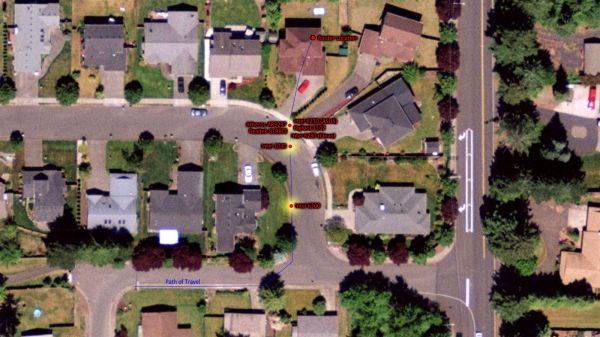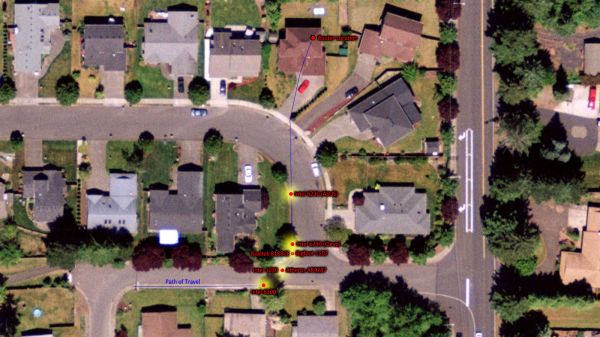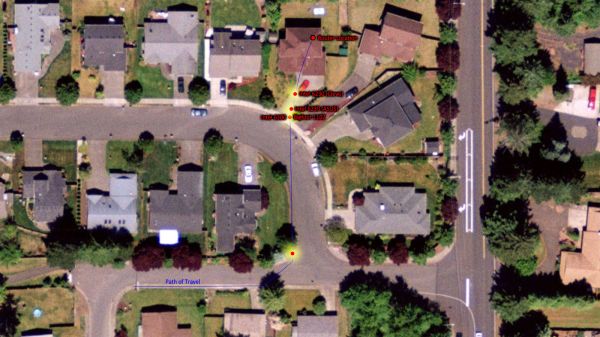Bigfoot’s Killer-N 1102 Wireless Networking vs. the World
by Jarred Walton on August 10, 2011 10:38 AM ESTTesting Signal Range
Throughput and latency are only two elements of wireless performance. Another important metric is how far a device can be from the router/access point before it drops the signal. For the Linksys E4200 router, we tested 2.4GHz and 5GHz performance with the other radio disabled (since we didn’t want the 5GHz capable laptops switching to 2.4GHz when the signal got weak). The routers were located in my office (one at a time) and I proceeded to walk out the front door with each laptop, closing the metal door behind me. It’s about 40 feet from the router to the front door (not in a direct line), and then I walked down the driveway and out into the street. I’ve created plots showing where I walked and how far I could go with each router and laptop combination. We’ll start with the Netgear results.
The vast majority of the laptops started having connection issues just past the end of my driveway. In fact, only two laptops did noticeably better, and one of those was only just barely better. The Intel 1030 maintained a connection about 20 feet further out than the other wireless devices, though throughput was understandably low (less than 5Mbps). The clear winner however is the Intel 6300. The third stream is almost certainly helping here with MRC, and perhaps the antenna and/or drivers have something to do with the performance as well. Regardless of the reason, the 6300 holds onto the wireless signal a good 60 feet farther than the 1030, and about 80 feet farther than the other wireless devices.
Moving to the Linksys E4200 and using the 2.4GHz radio, the results are substantially better than with the Netgear, thanks to a more powerful radio. Intel’s 6300 again goes the farthest before dropping out, reaching over 200 feet, likely thanks to the three spatial streams/antenna chains. The Atheros and Intel 1030 place second, just ~15 feet shy of the 6300, and Bigfoot’s 1102 and Realtek’s 8188CE are another ~15 feet behind the Atheros. Given the performance elsewhere, we weren’t particularly surprised to see Intel’s 6230 having the lowest coverage area, but it was a surprise to find that the ASUS K53E didn’t reach as far as the Clevo W150HR. Even though the K53E has worse coverage, keep in mind that it still works well in my entire yard and most of the neighboring houses—the latter point being good or bad, depending on whether you like sharing your wireless network.
When we shift over to a 5GHz signal, range drops significantly, providing even less coverage than the Netgear router. Higher frequency signals don’t propagate nearly as far, which can actually be beneficial for home environments—if all of my neighbors were using 5GHz wireless networks, I’d be lucky to see much less connect to any of them! This is one reason all the 5GHz capable cards perform so much better on a 5GHz network: lack of interference from neighboring networks (and microwaves, cordless phones, etc.). Of course, if you want a larger coverage area, even the worst result on 2.4GHz is about twice as far from the router as the best 5GHz result. Interesting to note is that in 5GHz testing, the Bigfoot 1102 actually has the best throughput out to near the end of my drive, pushing over 30Mbps until the last 5-10 feet. The cutoff point for 5GHz is really abrupt, and again that’s either good or bad depending on your intended use.
If reception at the limits of your wireless signal is important to you, the Intel 6300 appears to be the best bet (though potentially other 3x3:3 solutions might post similar results). However, we also need to consider throughput. Even though all of the devices technically maintained a 2.4GHz signal to the end of my driveway, I consider ~10Mbps of throughput to be the cutoff point for my purposes. In that case, right about where the red vehicle is parked is where I’d start getting irritated on the Netgear router, and maybe to the end of my driveway with the Linksys—except for the Intel 6300, which can go another 40 feet or so before dropping below 10Mbps. In general, even though some of the cards went farther before dropping the connection (or losing packets), throughput is much lower beyond the (metal) front door. All of the cards manage about 20-40Mbps inside the house, but close the front door and that quickly drops to 10-20Mbps. While that’s still faster than most Internet connections, latency starts to increase as well and periodic dropped packets become a concern.













52 Comments
View All Comments
neothe0ne - Sunday, August 14, 2011 - link
"And Dell, Asus, Acer, and Sony all do the same thing."Are you sure about that? I was under the impression HP and Lenovo were alone in the industry with the WLAN whitelist. And anyway, Dell does offer the Intel Centrino 6230 on the XPS 15 now, unlike HP's dv6 which is stuck in budget-tier Intel WiFi Link 1000 land.
cjl - Tuesday, August 16, 2011 - link
Dell, at least in their Alienware products, definitely does not whitelist. After reading this article, I got one of the Killer 1102 cards for my M11xR2 (which comes with a rather terrible card by default, and there were no upgrade options offered), and it works just fine. I popped it in, installed the drivers, and everything has been working great since.Musafir_86 - Thursday, August 11, 2011 - link
Hello,-Thanks for the article, but did you tested those adapters with or without any security/encryption/password protection scheme? I mean WEP or WPA/WPA2 - I think encryption put some overhead in the throughput.
Thanks.
JarredWalton - Thursday, August 11, 2011 - link
All testing was done with WPA2 AES. Most modern cards do fine with that, though a few years back it was sometimes slower IIRC.Musafir_86 - Thursday, August 11, 2011 - link
-Okay, thanks for the clarification. :)Yummer72 - Thursday, August 11, 2011 - link
Thanks for the informative review.I wonder if Bigfoot will continue to have an advantage if the "WLAN Optimizer" program was used with the other WiFi cards?
http://www.martin-majowski.de/wlanoptimizer/
I have personally seen significantly improved performance and the elimination of "lag spikes" (QuakeLive) with this software tweak.
Any comments?
JarredWalton - Thursday, August 11, 2011 - link
I'll give that a try; it could very well remove the spikes, leaving the primary advantage as the lower base latency.bhima - Thursday, August 11, 2011 - link
You should review that 95% color gamut matte screen in that Mythlogic ;)loopingz - Thursday, August 11, 2011 - link
First of all thanks for highlighting that I can change my wifi adaptator on my laptop. Mine is always frozing during transfert in windows (linux is fine).Second thanks for helping me choosing the good one.
I hesitate now between intel 6300 for range, correct performance and price, and the 110 2/3 for pure performance.
May be best of two worlds intel 6300 in the eeepc that travel a lot and bigfoot in the main home laptop.
Can I recycle a my old wifi card or a new one using an antenna and puting it in my desktop computer?
I will give try to Wlanoptimizer too because watching movie from the raid5 nas still not perfect (router linksys e3k).
Thanks for the good job.
name99 - Thursday, August 11, 2011 - link
"Wireless networking also tends to need more overhead for error checking and interference losses, and there’s a question of whether the streams are linearly independent enough to get higher throughput, orientation, directionality of signal, etc. Even though you might connect at 450Mbps or 300Mbps, you’ll never actually reach anywhere near that level of throughput. In our testing, the highest throughput we ever saw was around 75% utilization of the available bandwidth, and that was on a 300Mbps connection."This is not a useful description of the situation. The nominal speed of a connection (ie the MCS index) already includes error correction overhead --- that's why you see a range of bit-rates, with the same parameters (modulation, number of streams, bandwidth) --- these different bit-rates correspond to different levels of error correction, from the strongest (1/2 coding rate) to the weakest (5/6).
It is also unlikely that corrupt packets and the retransmission (what you are calling "interference losses", though in your environment noise is likely more relevant than interference) are substantial --- both ends aggressively modify the MCS index to get the best throughput, and try to keep the number of corrupt packets low.
The real issue is the MAC --- the negotiations over who next gets airtime. This used to be a big deal with wired ethernet as well, of course, but it went away with switches around the time we all moved to 100TX. The basic 802.11n MAC does not rely on any real co-ordination, just on timing windows and retries, and it wastes a phenomenal amount of time. 802.11e improves the situation somewhat (I expect all the systems that get 75% efficiency are using 802.11e, otherwise they'd see around 50% efficiency), but it's still not perfect.
What one really wants is a central arbiter (like in a cell system) that hands out time slots, with very specific rules about who can talk when. For reasons I don't understand, 802.11 has been very resistant to adding such a MAC protocol (802.11e has elements of this, but does not go full-hog), but I would not be surprised if we finally see such as part of the 802.11n successor --- it's just such an obvious place to pick up some improvement. The real problem is that to do it right you have to give up backward compatibility, and no-one wants to do that. At least if we'd had it in 802.11n, then we'd be part way to a better world (people could switch it on once all their g equipment died, eg at home).